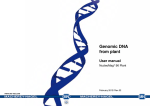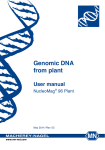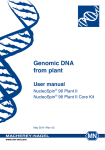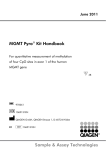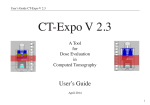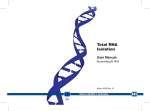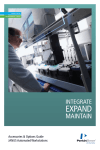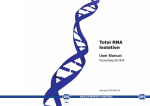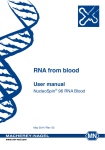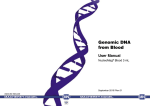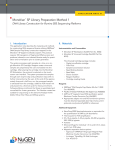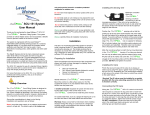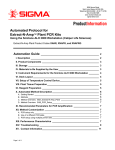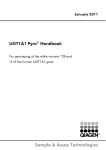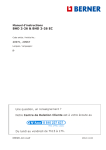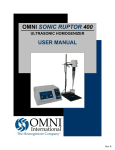Download Genomic DNA from Plant - Lab Supplies Scientific
Transcript
Genomic DNA from Plant User manual NucleoMag 96 Plant May 2005/Rev. 01 www.mn-net.com MACHEREY-NAGEL MN TÜV CERT DIN EN ISO 9001.2000 Certificate: 01 100 5507 MACHEREY-NAGEL MN Genomic DNA from Plant Table of contents 1 Kit contents 4 2 Product description 5 2.1 The basic principle 5 2.2 Magnetic separation systems 6 2.3 Adjusting the shaker settings 6 2.4 Handling of beads 7 2.5 Elution procedures 7 2.6 Storage and homogenization of samples 8 3 Storage conditions and preparation of working solutions 9 4 Safety instructions – risk and safety phrases 10 5 General procedure 11 5.1 Standard protocol for the purification of genomic DNA 6 Appendix 14 17 6.1 Troubleshooting 17 6.2 Ordering information 19 6.3 Product use restriction / warranty 19 MACHEREY-NAGEL – 05/2005/Rev.01 3 Genomic DNA from Plant 1 Kit contents NucleoMag 96 Plant 1 x 96 preps 4 x 96 preps 24 x 96 preps 744 400.1 744 400.4 744 400.24 NucleoMag C-Beads 3 ml 12 ml 72 ml Lysis Buffer MC1 60 ml 240 ml 3 x 480 ml 2 x 25 ml 8 x 25 ml 3 x 400 ml Wash Buffer MC3 75 ml 2 x 150 ml 2 x 900 ml Wash Buffer MC4 75 ml 2 x 150 ml 2 x 900 ml Wash Buffer MC5 75 ml 2 x 150 ml 2 x 900 ml Elution Buffer MC6 25 ml 100 ml 600 ml RNase A 15 mg 2 x 30 mg 12 x 30 mg Elution plate, U-bottom (including one Selfadhering PE foil) 1 4 24 Protocol 1 1 1 Cat. No. Binding Buffer MC2 Material to be supplied by user: - 80% Ethanol - Separation plate, e.g. Square-well Block - Homogenization tubes, e.g. MN Tube Strips and Cap Strips (see ordering information, section 6.2). 4 MACHEREY-NAGEL – 05/2005/Rev.01 Genomic DNA from Plant 2 Product description 2.1 The basic principle The NucleoMag 96 Plant procedure is based on reversible adsorption of nucleic acids to paramagnetic beads under appropriate buffer conditions. Plant tissue is extracted with CTAB-Lysis Buffer MC1. Adjusting the binding conditions of nucleic acid with Binding Buffer MC2 and addition of paramagnetic beads can be carried out simultaneously. After magnetic separation and removal of supernatant the paramagnetic beads are washed to remove contaminants and salt. There is no need for a drying step as ethanol from previous wash steps is removed by Wash Buffer MC5. Finally, highly purified DNA is eluted with low-salt Elution Buffer MC6 and can directly be used for downstream applications. The NucleoMag 96 Plant kit can be used either manually or automated on standard liquid handling instruments. Plant tissue is extracted with Lysis Buffer MC1. Binding conditions are adjusted and the NucleoMag Plant Beads are added to the sample. DNA is bound to the NucleoMag Plant Beads. Beads are held back in the well while contaminants are washed away. DNA is eluted from the beads and recovered, while beads are held back in the well by the magnet. DNA is ready-to-use in downstream applications. MACHEREY-NAGEL – 05/2005/Rev.01 5 Genomic DNA from Plant 2.2 Magnetic separation systems For use of NucleoMag 96 Plant the use of the magnetic separator NucleoMag SEP is recommended. Separation is carried out in an MN Square-well Block (see ordering information). The kit can also be used with other common separators. See suppliers ordering information for suitable separation plates. Magnetic separator NucleoMag SEP (Cat. No. 744 900) Promega MagnaBot Tecan Te-MagS Separation plate or tube Square-well Block (MN, Cat. No. 740 670) Square-well Block (MN, Cat. No. 740 670) 1.5 ml tubes without lid (Sarstedt) Static magnetic pins Separators with static magnetic pins, e.g. NucleoMag SEP (for manual use and for use on liquid handling workstations): This type of separator is recommended in combination with a plate shaker, e.g. H+P Variomag® Teleshake (H+P Labortechnik AG, Bruckmannring 28, D-85764 Oberschleißheim, Germany, www.hp-lab.de), for optimal resuspension of the beads during the washing and elution steps. Alternatively, beads can be resuspended in the buffer by pipetting up and down several times. For fully-automated use on liquid handling workstations a gripper tool is required, the plate is transferred to the magnetic separator for separation of the beads and transferred to the shaker module for resuspension of the beads. Movable magnetic systems Separators with moving magnetic pins, e.g. Te-MagS (for automated use only): Magnetic pins/rods are moved from one side of the well to the other and vice versa. Beads follow this movement and are thus pulled through the buffer during the wash and elution steps. Separation takes place when the system stops. 2.3 Adjusting the shaker settings When using a plate shaker for the washing and elution steps the speed settings have to be checked carefully for each specific separation plate and shaker to prevent cross-contamination from well to well. Proceed as follows: • Apply 600 µl dyed water (select desired elution buffer volume) to the wells of the separation plate. Position the plate on the shaker and start shaking with a moderate speed setting for 30 seconds. Turn off the shaker and check plate surface for small droplets of dyed water. • Increase speed setting, shake for an additional 30 seconds, and check plate surface for droplets again. • Continue increasing the speed setting until you observe droplets on top of the separation plate. Reduce speed setting, check again and use this setting for the washing and elution step. 6 MACHEREY-NAGEL – 05/2005/Rev.01 Genomic DNA from Plant 2.4 Handling of beads Distribution of beads A homogenous distribution of the magnetic beads to the individual wells of the separation plate is essential for a high well-to-well consistency. Therefore, before distributing the beads make sure that the beads are completely resuspended. Shake the storage bottle well or place it on a vortex shortly. Premixing magnetic beads with the binding buffer allows easier homogenous distribution of the beads to the individual wells of the separation plate. During automation, a premix step before aspirating the beads/binding buffer mixture from the reservoir is recommended to keep the beads resuspended. Magnetic separation time Attraction of the magnetic beads to the magnetic pins depends on the magnetic strength of the magnetic pins, the selected separation plate, distance of the separation plate from the magnetic pins, and the volume to be processed. The individual times for complete attraction of the beads to the magnetic pins should be checked on each system. It is recommended to use the separation plates or tubes specified by the supplier of the magnetic separator. Washing the beads Washing the beads can be achieved by shaking or mixing. In contrast to mixing by pipetting up and down mixing by shaker or magnetic mixing allows simultaneous mixing of all samples. This reduces the time and number of tips needed for the preparation. Resuspension by pipetting up and down is more efficient than mixing by a shaker or magnetic mix. Method Magnetic mix Shaker Pipetting Resuspension Efficiency + ++ +++ Speed ++ ++ +* Small elution volume possible + +++ ++ Number of tips needed Low Low High * 8-channel pipetting device 2.5 Elution procedures Purified genomic DNA can be eluted directly with the supplied Elution Buffer MC6. Elution can be carried out in a volume of ≥ 50 µl. It is essential to cover the NucleoMag Plant Beads completely with elution buffer during the elution step. The volume of dispensed elution buffer depends on the magnetic separation system (the position of the pellet inside the separation plate). For efficient elution the magnetic bead pellet should be resuspended completely in the elution buffer. For some separators high elution volumes might be necessary to cover the whole pellet. Elution is possible at room temperature. Yield can be increased by 15 – 20% if elution is performed at 55oC. MACHEREY-NAGEL – 05/2005/Rev.01 7 Genomic DNA from Plant 2.6 Storage and homogenization of samples We recommend to use young plant samples and if possible to keep plants for about 12 h in the dark before collecting samples in order to reduce polysaccharide content. Plant samples can be stored frozen, under ethanol or lyophilized. In many cases lyophilized, dried material can be easier processed and gives higher yield. If using dried samples reduce the amount of starting material by the factor 5 e.g. use 10 mg dried plant leaves instead of 50 mg fresh weight. As plant tissue is very robust, the lysis procedure is most effective with well homogenized, powdered samples. Suitable methods include grinding with pestle and mortar in the presence of liquid nitrogen or using steel beads. We also recommend the use of other commercial homogenizers, bead mills etc. Methods to homogenize samples Commercial homogenizers, for example Crush Express for 96-well homogenization (contact Saaten-Union Resistenzlabor GmbH, D-33818 Leopoldshöhe), Tissue Striker (www.KisanBiotech.com) or Geno/Grinder 2000 (www.spexcsp.com or for Germany www.c3-analysentechnik.de) Homogenizing samples by VA steel beads (diameter: 7 mm): Put 4-5 beads and plant material together into a 15 ml plastic tube (Falcon), chill the tube in liquid nitrogen and vortex for about 30 seconds (e.g. with a Multi Pulse Vortexer, contact Schütt Labortechnik GmbH, Postfach 3454, D-37024 Göttingen, Germany). Repeat this chilling and vortexing procedure until the entire plant material is ground to a powder. Chill the tube once more and remove the beads by rolling them out gently or with a magnet. Keep the material frozen throughout the whole homogenization procedure. Do not add nitrogen to the tube! This leads to sticking and loss of plant material attached to the beads. 8 MACHEREY-NAGEL – 05/2005/Rev.01 Genomic DNA from Plant 3 Storage conditions and preparation of working solutions Attention: Buffers MC3 and MC4 contain chaotropic salt! Wear gloves and goggles! Buffer MC2 is highly flammable and irritant. All components of the NucleoMag 96 Plant kit should be stored at room temperature (20-25°C) and are stable for up to one year. All buffers are delivered ready-to-use. Before starting any NucleoMag 96 Plant protocol prepare the following: • RNase A: Add the indicated volume of water to RNase A. Store at 4°C. • 80% Ethanol: use molecular biology grade ethanol, dilute with appropriate water to 80%. NucleoMag 96 Plant Cat. No. RNase A (lyophilized) 1 x 96 preps 4 x 96 preps 24 x 96 preps 744400.1 744400.4 744400.24 1 x 15 mg 2 x 30 mg add 1.25 ml water add 2.5 ml water to each vial MACHEREY-NAGEL – 05/2005/Rev.01 12 x 30 mg add 2.5 ml water to each vial 9 NucleoMag 96 Plant 4 Safety instructions – risk and safety phrases The following components of the NucleoMag 96 Plant kits contain hazardous contents. Wear gloves and goggles and follow the safety instructions given in this section. Component Hazard Contents Hazard Symbol isopropanol MC2 F∗ Xi ∗ Risk Safety Phrases Phrases Highly flammable. Irritating to eyes. Vapours may cause drowsiness and dizziness. MC3 sodium perchlorate in ethanol Xn∗∗ Flammable. Harmful if swallowed. Irritating to eyes and skin MC4 sodium perchlorate in ethanol Xn RNase A RNase A, lyophilized R 11-36-67 S 7-1624/25-26 R 10-2236/38 S 7-16 R 22-10 S 13-22-27 ∗∗ Harmful if swallowed. Flammable ∗ May cause sensitization by inhalation R 42/43 and skin contact Xi S 7-16-22 Risk Phrases R 10 Flammable R 11 Highly flammable R 22 Harmful if swallowed R 36 Irritating to eyes R 36/38 Irritating to eyes and skin R 42/43 May cause sensitization by inhalation and skin contact R 67 Vapours may cause drowsiness and dizziness Safety Phrases S7 Keep container tightly closed S 13 Keep away from food, drink and animal feedingstuffs S 16 Keep away from sources of ignition - No smoking! S 22 Do not breathe dust S 24 Avoid contact with skin S 24/25 Avoid contact with skin and eyes S 27 Take off immediately all contaminated clothing ∗ Label not necessary, if quantity below 25 g or ml (concerning 67/548/EEC Art. 25, 1999/45/EC Art. 12 and German GefStoffV § 42 and TRGS 200 7.1) ∗∗ Label not necessary, if quantity below 125 g or ml (concerning 67/548/EEC Art. 25, 1999/45/EC Art. 12 and German GefStoffV § 42 and TRGS 200 7.1) 10 MACHEREY-NAGEL – 05/2005/Rev.01 NucleoMag 96 Plant 5 1 General procedure Homogenize and lyse plant samples (20-50 mg). Homogenization, add 500 µl MC1 buffer, mix and incubate at 56°C, 30 min 2 3 Clear lysate by centrifugation, transfer 400 µl of cleared lysate to a Squarewell Block for further processing. 5,600 x g Bind DNA to NucleoMag Plant Beads. 400 µl cleared lysate 30 µl C-beads 400 µl MC2 shake 5 min at RT 4 Remove supernatant. 2 min separation 5 MC3 wash step. 600 µl MC3 shake 5 min, RT optional: mix by pipetting up and down 2 min separation MACHEREY-NAGEL – 05/2005/Rev.01 11 NucleoMag 96 Plant 6 MC4 wash step. 600 µl MC4 shake 5 min, RT optional: mix by pipetting up and down 2 min separation 7 80% Ethanol wash step. 600 µl 80% Ethanol, shake 5 min, RT optional: mix by pipetting up and down 2 min separation 8 MC5 wash step. 600 µl MC5 60 sec incubation aspirate and discard supernatant Note: Do not resuspend beads in MC5 buffer 12 MACHEREY-NAGEL – 05/2005/Rev.01 NucleoMag 96 Plant 9 Elute genomic DNA and transfer to Elution Plate. 50 – 200 µl MC6 shake 5 min, RT 2 min separation transfer Optional: Elution at 55oC MACHEREY-NAGEL – 05/2005/Rev.01 13 NucleoMag 96 Plant 5.1 Standard protocol for the purification of genomic DNA This protocol is designed for magnetic separators with static pins (e.g. NucleoMag SEP) and suitable plate shakers (e.g. H+P Variomag® Teleshake). This protocol is for manual use and serves as a guideline for adapting the kit to robotic instruments. For the availability of ready-to-run scripts please contact your local distributor or MN directly. 1 Homogenize and lyse sample material Homogenize about 20-50 mg (lyophilized) plant tissue, e.g. using mictrotube strips in a mixer mill, and add 500 µl MC1 lysis buffer. Do not moisten the rim. Close the individual wells with cap strips. Mix by vigorous shaking for 15-30 sec. Spin briefly for 30 sec at 1,500 x g to collect any sample from the cap strips. Incubate the closed strips at 56°C for 30 min. Optional: If samples contain large amounts of RNA, we recommend the addition of 10 µl RNase A solution (stock solution 12 mg/ml) to the MC1 lysis mixture. 2 Clear lysate Centrifuge the samples for 20 min at a full speed (5,600 - 6,000 x g). Remove cap strips. 3 Transfer 400 µl of the cleared lysate (equilibrated to room temperature) to a Square-well Block. Do not moisten the rims of the well. Note: See recommendations for suitable plates or tubes and compatible magnetic separators section 2.3. 4 Add 400 µl Binding Buffer MC2 and 30 µl of NucleoMag Plant Beads to each well of the Square-well Block. Mix immediately by shaking (5 min) at room temperature. Alternatively, pipette up and down 10 times and incubate 5 min at room temperature. Note: NucleoMag Plant Beads and Binding Buffer MC2 can be premixed. For 96 samples mix at least 2880 µl of NucleoMag Plant Beads with 38,4 ml of buffer MC2, mix by vortexing. Use 430 µl of the suspension per well. Be sure to resuspend the NucleoMag Plant Beads before removing them from the storage bottle. Vortex storage bottle briefly until a homogenous suspension has formed. 14 MACHEREY-NAGEL – 05/2005/Rev.01 NucleoMag 96 Plant 5 Separate the magnetic beads against the side of the wells by placing the Squarewell Block on the magnetic separator. Wait at least 2 min until all the beads have been attracted to the magnet. Remove and discard supernatant by pipetting. Remove the Square-well Block from the magnetic separator. Note: Do not disturb the attracted beads while aspirating the supernatant. The magnetic pellet is not visible in this step. Remove supernatant from the opposite side of the well. 6 Add 600 µl Wash Buffer MC3 to each well and wash the bead/DNA complex by shaking (5 min) at room temperature. Alternatively, pipette up and down 15 times. Separate all of the magnetic beads against the side of the well by placing the Square-well Block on the magnetic separator as described above. Aspirate and discard the supernatant. Remove the Square-well Block from the magnetic separator. 7 Add 600 µl Wash Buffer MC4 to each well and wash the bead/DNA complex by shaking (5 min) at room temperature. Alternatively, pipette up and down 15 times. Separate all of the magnetic beads against the side of the well by placing the Square-well Block on the magnetic separator as described above. Aspirate and discard the supernatant. 8 Add 600 µl 80% ethanol to each well and wash the bead/DNA complex by shaking (5 min) at room temperature. Alternatively, pipette up and down 15 times. Separate all of the magnetic beads against the side of the well by placing the Square-well Block on the magnetic separator as described above. Aspirate and discard the supernatant. Do not remove the Square-well Block from the magnetic separator. Note: Supernatant is colorless, magnetic bead pellet is clearly visible. 9 Add 600 µl Wash Buffer MC5 to each well and incubate for 60 s while the beads are still separated on the magnet. Then aspirate and discard the supernatant. Note: Do not resuspend the beads in Wash Buffer MC 5. This step is to remove traces of ethanol and eliminates a drying step. MACHEREY-NAGEL – 05/2005/Rev.01 15 NucleoMag 96 Plant 10 Add desired volume of Elution Buffer MC6 (50 – 200 µl) to each well and resuspend the bead/DNA complex by shaking (5 – 10 min). Alternatively, pipette up and down 10 times and incubate 5 – 10 min. Separate the magnetic beads against the side of the wells by placing the Squarewell Block on the magnetic separator. Wait 2 min until all the beads have been attracted to the magnet. Transfer the supernatant containing the purified genomic DNA to the Elution Plate. Note: The yield can be increased by 15 – 20% by using prewarmed elution buffer (55°C) or by incubating the bead/elution buffer suspension at 55°C for 10 min. 16 MACHEREY-NAGEL – 05/2005/Rev.01 Genomic DNA from Plant 6 Appendix 6.1 Troubleshooting Problem Possible cause and suggestions Elution buffer volume insufficient • Beads pellet must be covered completely with elution buffer Insufficient performance of elution buffer during elution step • Remove residual buffers during the separation steps completely. Remaining buffers decrease efficiency of following wash steps and elution step. Beads dried out • Do not let the beads dry as this might result in lower elution efficiencies. Partial elution in Wash Buffer MC5 already Poor DNA yield • Keep the beads on the magnet while dispensing Wash Buffer MC5. Do not resuspend beads in this buffer, and do not incubate beads in this buffer for more than 2 min, as this buffer is water-based and might elute the DNA already. Aspiration of attracted bead pellet • Do not disturb the attracted beads while aspirating the supernatant, especially when the magnetic pellet is not visible in the lysate. Incubation after dispensing beads to lysate • Mix immediately after dispensing NucleoMag Plant Beads/Binding Buffer MC2 to the lysate. Insufficient washing procedure Low purity • Use only the appropriate combinations of separator and plate, e.g. MN Square-well Block in combination with NucleoMag SEP. MACHEREY-NAGEL – 05/2005/Rev.01 17 Genomic DNA from Plant Problem Possible cause and suggestions Carry-over of ethanol from 80% ethanol wash solution Suboptimal performance of DNA in downstream applications • Be sure to remove all of the ethanolic wash solution, as residual ethanol interferes with downstream applications. Low purity • see above Time for magnetic separation too short • Carry-over of beads Increase separation time to allow the beads to be completely attracted to the magnetic pins before aspirating any liquid from the well. Aspiration speed too high (elution step) • High aspiration speed during the elution step may cause bead carry over. Reduce aspiration speed for elution step. Contamination of the rims Cross contamination 18 • Do not moisten the rims of the Square-well Block when transferring the plant lysate. If the rim of the wells is contaminated, seal the Square-well Block with selfadhering PE foil (see ordering information) before starting the shaker. MACHEREY-NAGEL – 05/2005/Rev.01 Genomic DNA from Plant 6.2 Ordering information Product Cat. No. Pack of NucleoMag 96 Plant 744 400.1 1 x 96 NucleoMag 96 Plant 744 400.4 4 x 96 NucleoMag 96 Plant 744 400.24 24 x 96 NucleoMag SEP 744 900 1 Square-well Blocks 740 670 20 Self-adhering PE foil 740 676 50 sheets MN Tube Strips 740 637 5 sets Cap Strips 740 638 30 strips 6.3 Product use restriction / warranty NucleoMag 96 Plant kit components were developed, designed and sold for research purposes only. They are suitable for in vitro uses only. No claim or representation is intended for its use to identify any specific organism or for clinical use (diagnostic, prognostic, therapeutic, or blood banking). It is rather the responsibility of the user to verify the use of the NucleoMag 96 Plant kit for a specific application range as the performance characteristic of this kit has not been verified to a specific organism. This MACHEREY-NAGEL product is shipped with documentation stating specifications and other technical information. MACHEREY-NAGEL warrants to meet the stated specifications. MACHEREY-NAGEL´s sole obligation and the customer´s sole remedy is limited to replacement of products free of charge in the event products fail to perform as warranted. Supplementary reference is made to the general business terms and conditions of MACHEREY-NAGEL, which are printed on the price list. Please contact us if you wish an extra copy. MACHEREY-NAGEL does not warrant against damages or defects arising in shipping and handling (transport insurance for customers excluded), or out of accident or improper or abnormal use of this product; against defects in products or components not manufactured by MACHEREY-NAGEL, or against damages resulting from such non-MACHEREY-NAGEL components or products. MACHEREY-NAGEL makes no other warranty of any kind whatsoever, and SPECIFICALLY DISCLAIMS AND EXCLUDES ALL OTHER WARRANTIES OF ANY KIND OR NATURE WHATSOEVER, DIRECTLY OR INDIRECTLY, EXPRESS OR IMPLIED, INCLUDING, WITHOUT LIMITATION, AS TO THE SUITABILITY, MACHEREY-NAGEL – 05/2005/Rev.01 19 Genomic DNA from Plant REPRODUCTIVITY, DURABILITY, FITNESS FOR A PARTICULAR PURPOSE OR USE, MERCHANTABILITY, CONDITION, OR ANY OTHER MATTER WITH RESPECT TO MACHEREY-NAGEL PRODUCTS. In no event shall MACHEREY-NAGEL be liable for claims for any other damages, whether direct, indirect, incidental, compensatory, foreseeable, consequential, or special (including but not limited to loss of use, revenue or profit), whether based upon warranty, contract, tort (including negligence) or strict liability arising in connection with the sale or the failure of MACHEREY-NAGEL products to perform in accordance with the stated specifications. This warranty is exclusive and MACHEREY-NAGEL makes no other warranty expressed or implied. The warranty provided herein and the data, specifications and descriptions of this MACHEREY-NAGEL product appearing in MACHEREY-NAGEL published catalogues and product literature are MACHEREY-NAGEL´s sole representations concerning the product and warranty. No other statements or representations, written or oral, by MACHEREY-NAGEL´s employees, agent or representatives, except written statements signed by a duly authorized officer of MACHEREY-NAGEL are authorized; they should not be relied upon by the customer and are not a part of the contract of sale or of this warranty. Product claims are subject to change. Therefore please contact our Technical Service Team for the most up-to-date information on MACHEREY-NAGEL products. You may also contact your local distributor for general scientific information. Applications mentioned in MACHEREY-NAGEL literature are provided for informational purposes only. MACHEREY-NAGEL does not warrant that all applications have been tested in MACHEREY-NAGEL laboratories using MACHEREY-NAGEL products. MACHEREY-NAGEL does not warrant the correctness of any of those applications. Please contact: MACHEREY-NAGEL Germany Tel.: +49-2421/969 270 and 275 e-mail: [email protected] 20 MACHEREY-NAGEL – 05/2005/Rev.01




















